PRESTO PLANS
Sent straight to your inbox
CLICK HERE TO ACCESS
Sign up to receive 10 ready-to-use ELA resources your students will love!
10 FREE ELA RESOURCES
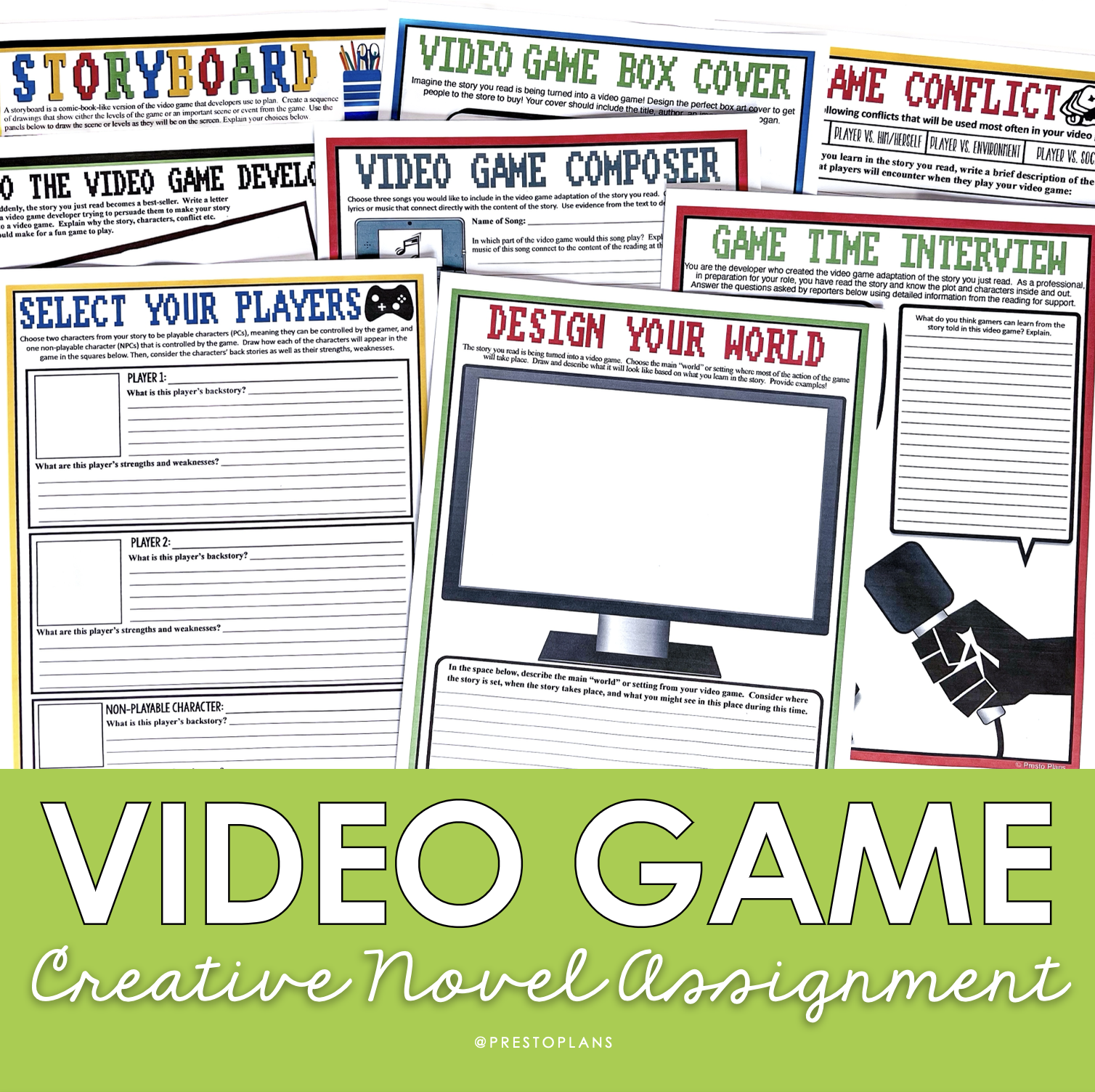
Turn a Story into a Video Game: Creative Assignment For Any Novel or Short Story
Are your middle school ELA students obsessed with video games? I know that lately, gaming is all that some students want to talk about! I also know that leaning into students’ interests creates instant buy-in. With this in mind, I came up with a multi-stage assignment that brings elements of video games into the middle school ELA classroom. Combining the creativity of video games with the literacy skills required in English language arts keeps students engaged through the entire learning process.
Turning a Story into a Video Game Assignment is a flexible, appealing, and open-ended project that works at the end of almost any short story unit or novel study. What I love most about it is how versatile it is – you can use each of its eight components individually, or combine them into one large culminating assignment.
It’s especially great for reluctant readers, or anyone who needs to make an outside-the-box connection with middle school ELA students. Best of all, both printer-friendly and digital versions of this assignment are available to help you meet the needs of all your learners. Here’s how it works:
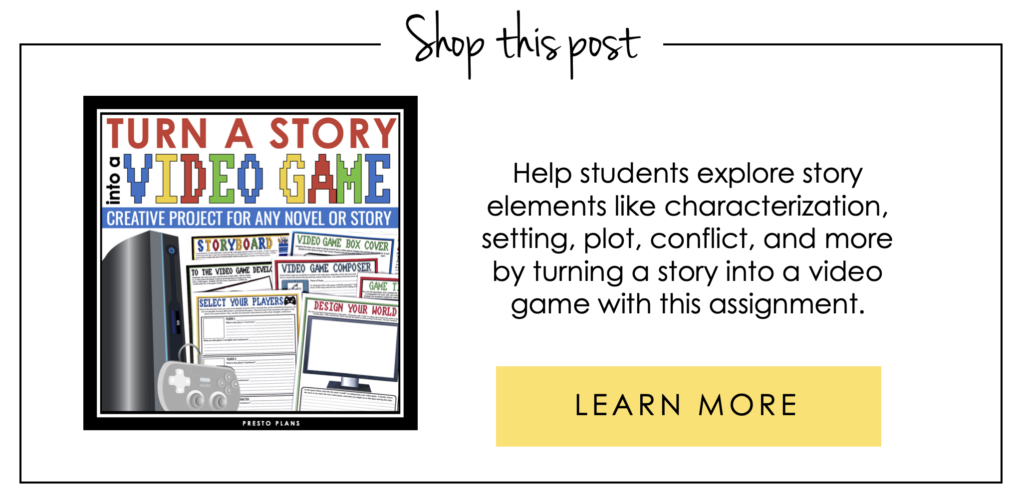
Letter to the Video Game Developer
To begin, I like to invite my students to imagine that the story or novel they just read has become a best-seller. What happens to best-selling books? They need a video game tie-in, of course!
In this initial task, they need to write a letter to a video game developer. The purpose of the letter is to persuade the developer to make the story into a video game. As they write, middle school ELA students need to make a compelling argument for why the characters or conflict of the story would make for a fun game to play.
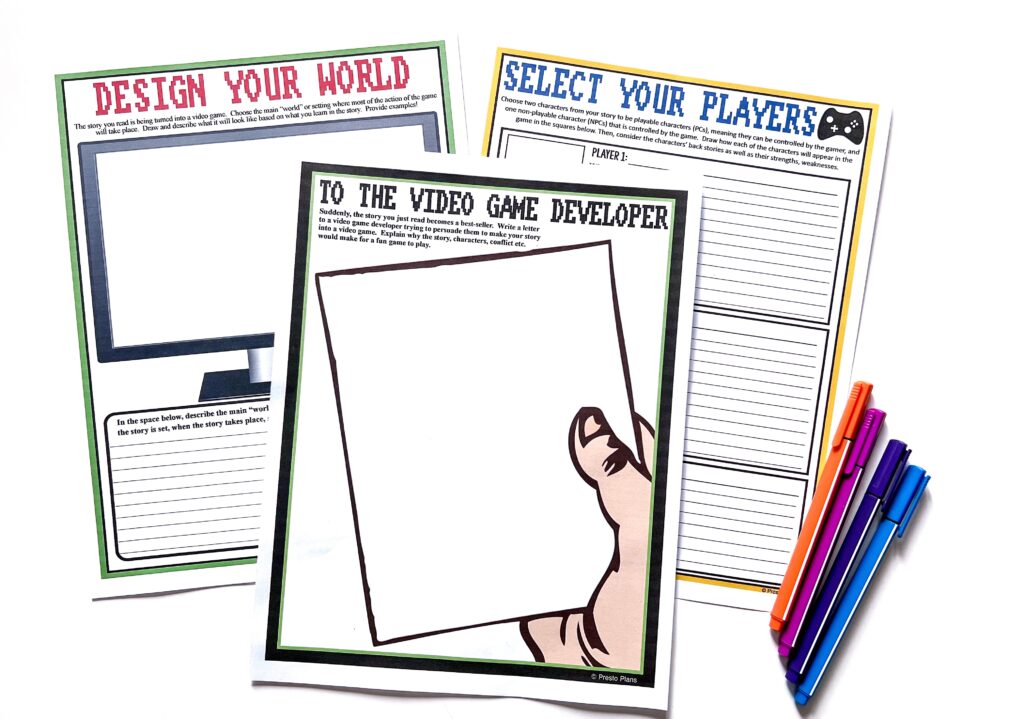
Select Your Players
Once the letter is complete, I like to ask students to choose three characters from the book or story, and determine how they will be controlled in the context of their video game.
Two of the characters they choose will be “playable” characters (PCs), meaning they can be controlled by the gamer. A third character will be a “non-playable” character, whose actions are controlled by the game.
As part of this exercise, I like to encourage students to draw the characters and describe them in detail. To extend this exercise, you can also get your students to consider characters’ backstories, as well as their strengths and weaknesses.
Design Your World
In my opinion, one of the most engaging things about video games are the rich and complex worlds the characters live in. To bring this element of video games into the middle school ELA classroom, I like to have my students design the main “world” (AKA the setting) where most of the action of the game will take place.
During this process, I like to encourage students to use specific evidence from the novel or story to create their setting. As they create their design, students should consider where and when the story takes place, as well as the objects, structures, and potential obstacles they need to include.
Video Game Box Cover
What would a video game be without creative cover art? I like to begin this task by leading a quick brainstorming session about the type of designs that would encourage someone to buy a video game.
After the discussion, I outline the necessary features of a video game box cover, including the title, author, image, and a slogan. As part of this process, I sometimes ask them to write a brief persuasive description of the game to include on the back of the “case,” as well as a quote or snippet from a “five-star review!”
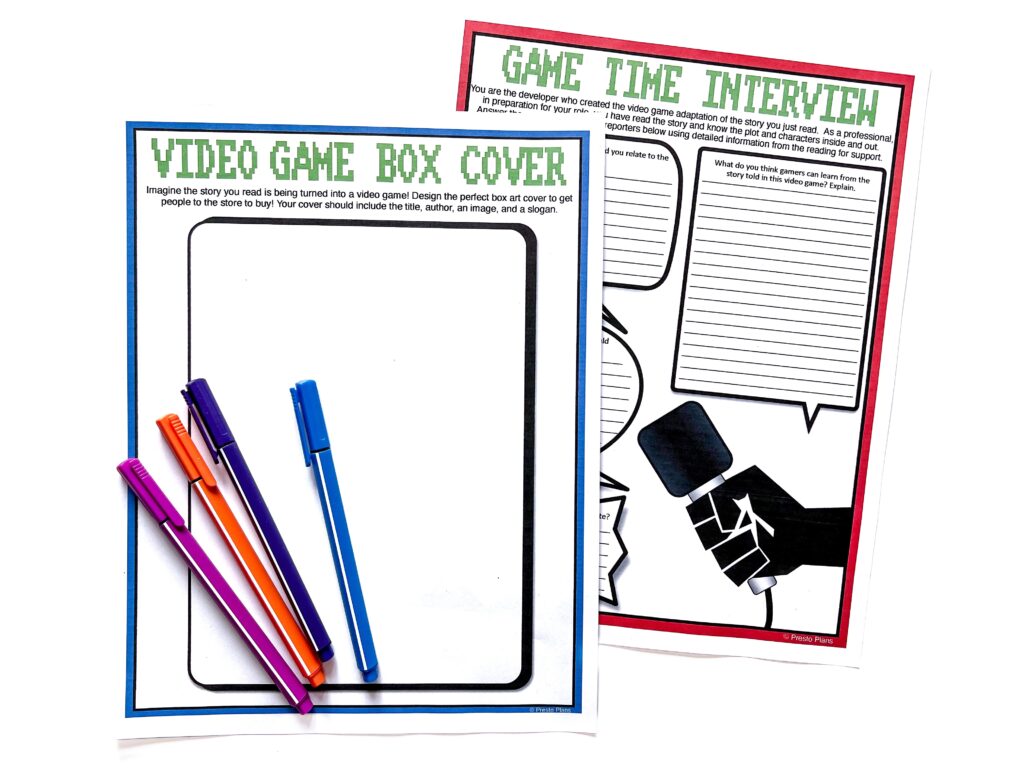
Storyboard
When bringing the idea of a book-turned-video game into the ELA class, one project students will often spend the most time on is storyboarding the game itself.
I usually start by explaining that video game developers use storyboards – comic-book-like versions of the video game – to plan key scenes. After this discussion, students create a sequence of drawings to either show the levels of the game, or an important scene or event. Then, they explain and justify their choices, using evidence from the book or story to support their thinking.
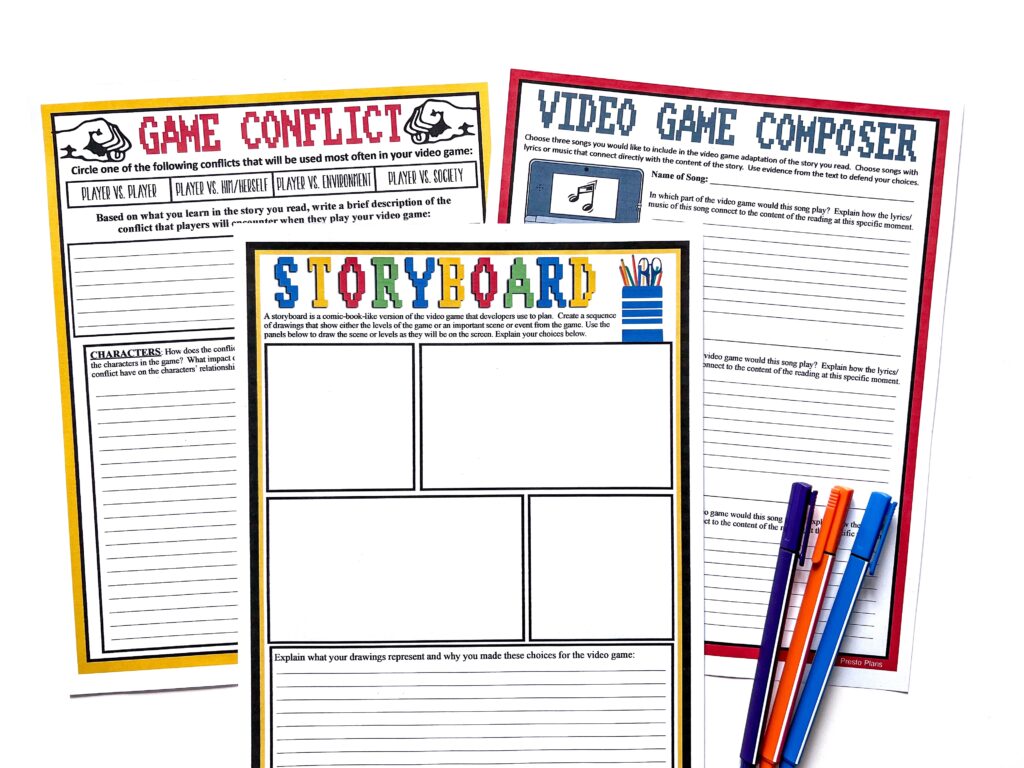
Video Game Composer
I think that one of the most underrated parts of any video game is its score. Music has the power to set the mood and tone of any scene, and the dramatic scenes of a video game are no exception!
In the Video Game Composer task, I begin by asking students to think of three songs they would like to include in their video game adaption of a short story or novel.
First, they need to explain which part of the video game each song would be used in. Next, they give details about how the lyrics or melody of each song connect to specific moments in the story or novel. I find this is a really effective way to encourage students to justify their thinking!
Game Conflict
Bringing video games into the ELA classroom presents a great opportunity to discuss the various types of conflicts in narrative writing. I usually begin by explaining the different types of conflict in the context of gaming – player vs. player, player vs. self, player vs. environment, and player vs. society.
After this discussion, students choose a conflict for players to encounter during their game, and explain their choice. Once they make their choice, I invite them to consider this conflict in terms of its impact on the characters of the game, as well as the overall mood and tone. Specifically, I might have them discuss how the conflict affects the relationship between the various characters. As an alternative, they could also write about how the game developer conveys different emotions through the conflict.
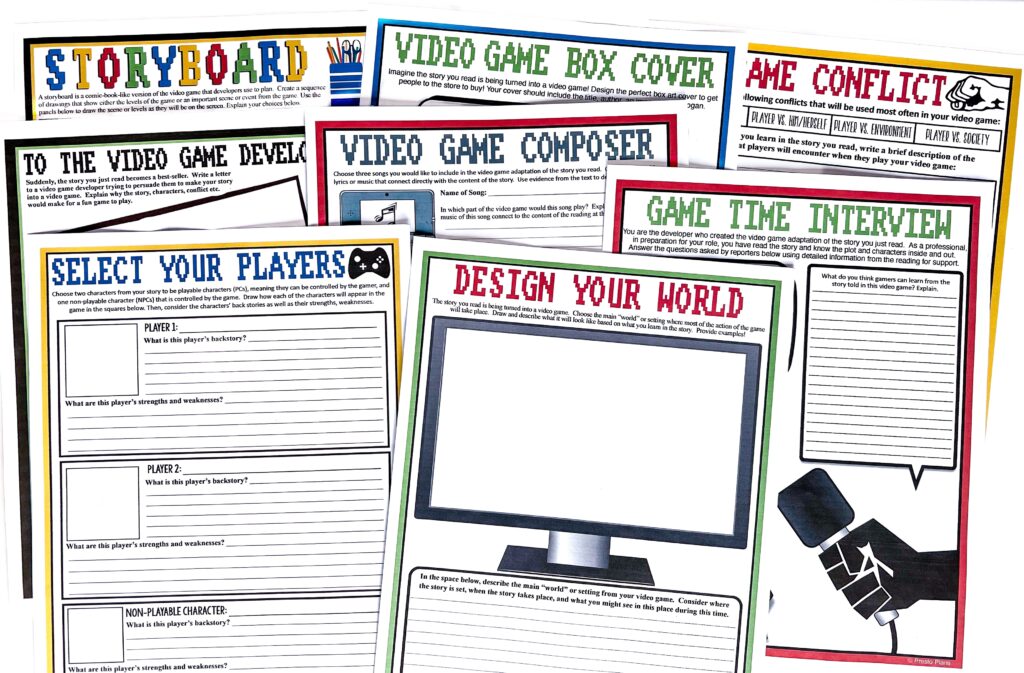
Game Time Interview
In the final task for Turn A Story Into a Video Game, students take on the role of the developer who created the video game adaptation of the story or novel. I start by asking students to imagine that they are being interviewed for Game Time magazine. With this in mind, they consider the answers to questions like:
- What kind of person would like to play this game?
- What do you think gamers can learn from the story told in this video game?
- What was the most difficult scene from the game to create?
As they respond to each question in short paragraphs, students explain their thinking with specific references to the plot and characters from the novel or short story. Once their drafts are complete, you could even have your students design and format the interview as it would appear in an actual gaming magazine, complete with images and pull quotes!
I hope these ideas help you find creative ways to incorporate video games into your ELA class, and connect with the gamers in your school! The digital version of this activity is available here.

Looking to give students more autonomy when it comes to reading? Transform your middle school ELA classroom with the Empowered Readers course!
Check out my post on 10 Tips to Engage Reluctant Readers in Middle School for more ideas to support your students.
Search the blog for what you are teaching
GIVEAWAYS
sent straight to your inbox!
share this post